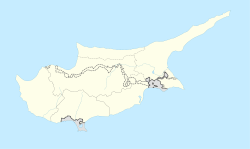Stavrovouni Monastery
| Σταυροβούνι | |

The entrance to the Monastery.
|
|
| Monastery information | |
|---|---|
| Full name | Holy Monastery of Stavrovouni |
| Other names | Monastery of the Precious and Life-giving Cross |
| Order | Orthodox monasticism |
| Established | 327–329 AD |
| Dedicated to | Holy Cross |
| Diocese | Church of Cyprus |
| People | |
| Founder(s) | Saint Helena |
| Prior | Archimandrite Elder Athanasios |
| Architecture | |
| Style | Byzantine |
| Site | |
| Location | near Pyrga, Larnaca District |
| Country | Cyprus |
| Coordinates | 34°53′09″N 33°26′08″E / 34.885875°N 33.435499°E |
| Visible remains | Church, Holy Cross |
| Public access | Men only |
Coordinates: 34°53′09″N 33°26′08″E / 34.885875°N 33.435499°E
Stavrovouni Monastery (Greek: Ιερά Μονή Σταυροβουνίου) is a Greek Orthodox monastery which stands on the top of a hill called Stavrovouni (Greek: Σταυροβούνι) in Cyprus; it is sometimes simply known as Stavrovouni. The monastery is one of the few places where one can see a piece of the Holy Cross. Stavrovouni Monastery was founded by Saint Helena (Saint Constantine's mother) in around 327–329 AD and therefore it is one of the oldest monasteries in the world.
The monastery is located on the peak of the mountain of the same name (Stavrovouni) in the District of Larnaca. The mountain in earlier times had been known under the name of Olympus, but nowadays the highest point of the Troodos Mountains further to the west bears that name. Stavrovouni, as the name already indicates, is dedicated to the Holy Cross; it can be derived from two words 'stavros' (Greek: Σταυρός) for cross and 'vouno' (βουνό) for mountain, so that it basically means "the mountain of the Cross".
According to religious tradition, the monastery was founded by St. Helena, the mother of the Byzantine Emperor Constantine I, the Great. According to the 15th century Cypriot chronicler Leontios Makhairas, after the end of the First Ecumenical Synod in Nicaea (325), Helena went on a pilgrimage to the Holy Land when she discovered the three crosses on which Jesus and the two thieves had been crucified. She had them excavated and wanted to bring them to Constantinople, but she is said to have left one of these crosses in Cyprus during an involuntary visit caused by shipwreck. Religious history says that the Holy Cross was transferred by a miracle to the peak of a high hill overnight and that a strong light was coming out of that peak. After several unsuccessful attempts to get the Holy Cross out of that mountain, Helena decided to leave a piece there, and built a small chapel to accompany it.
...
Wikipedia

